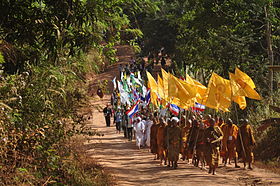
Back সাম্প্রদায়িকতা Bengali/Bangla Kommunalismus (Südasien) German Communalisme (Asie du Sud) French सांप्रदायिक हिंसा Hindi Komunalisme (Asia Selatan) ID Komunalizm Polish Conflito intercomunitário Portuguese پنگتي تڪرار Sindhi

Communal violence is a form of violence that is perpetrated across ethnic or communal lines, where the violent parties feel solidarity for their respective groups and victims are chosen based upon group membership.[1] The term includes conflicts, riots and other forms of violence between communities of different religious faith or ethnic origins.[2]
United Nations Office on Drugs and Crime includes any conflict and form of violence between communities of different religious groups, different sects or tribes of same religious group, clans, ethnic origins or national origin as communal violence.[3] However, this excludes conflict between two individuals or two families.
Communal violence is found in Africa,[4][5] the Americas,[6][7] Asia,[8][9] Europe[10] and Oceania.[11]
The term "communal violence" was coined by European colonial authorities as they wrestled to manage outbreaks of violence between religious, ethnic and disparate groups in their colonies, particularly Africa and South Asia, in early 20th century.[12][13][14]
Communal violence, in different parts of the world, is alternatively referred to as ethnic violence, non-State conflict, violent civil disorder, minorities unrest, mass racial violence, inter-communal violence and ethno-religious violence.[15]
- ^ Horowitz, D.L. (2000) The Deadly Ethnic Riot. University of California Press, Berkeley and Los Angeles, CA
- ^ Communal[dead link] Oxford Dictionaries
- ^ Homicide, Violence and Conflict UNODC, United Nations
- ^ Kynoch, G. (2013). Reassessing transition violence: Voices from South Africa's township wars, 1990–4. African Affairs, 112(447), 283–303
- ^ John F. McCauley, Economic Development Strategies and Communal Violence in Africa, Comparative Political Studies February 2013 vol. 46 no. 2 182–211
- ^ Willis, G. D. (2014), Antagonistic authorities and the civil police in Sao Paulo Brazil, Latin American Research Review, 49(1), 3–22
- ^ Resource guide for municipalities UNODC
- ^ Mancini, L. (2005) Horizontal Inequality and Communal Violence: Evidence from Indonesian Districts (CRISE Working Paper No. 22, Oxford, Queen Elizabeth House, University of Oxford)
- ^ Werbner, P. (2010), Religious identity, The Sage handbook of identities, ISBN 978-1412934114, Chapter 12
- ^ Todorova, T. (2013), ‘Giving Memory a Future’: Confronting the Legacy of Mass Rape in Post-conflict Bosnia-Herzegovina, Journal of International Women's Studies, 12(2), 3–15
- ^ Bell, P., & Congram, M. (2013), Communication Interception Technology (CIT) and Its Use in the Fight against Transnational Organised Crime (TOC) in Australia: A Review of the Literature, International Journal of Social Science Research, 2(1), 46–66
- ^ Cite error: The named reference
gvkwas invoked but never defined (see the help page). - ^ Arafaat A. Valiani, Militant Publics in India: Physical Culture and Violence in the Making of a Modern Polity, ISBN 978-0230112575, Palgrave Macmillan, pp 29–32
- ^ David Killingray, Colonial Warfare in West Africa, in Imperialism and War: Essays on Colonial Wars in Asia and Africa (Edited by Jaap A. de Moor, H. L. Wesseling), ISBN 978-9004088344, Brill Academic
- ^ Donald Horowitz (1985), Ethnic Groups in Conflict, ISBN 978-0520053854
© MMXXIII Rich X Search. We shall prevail. All rights reserved. Rich X Search